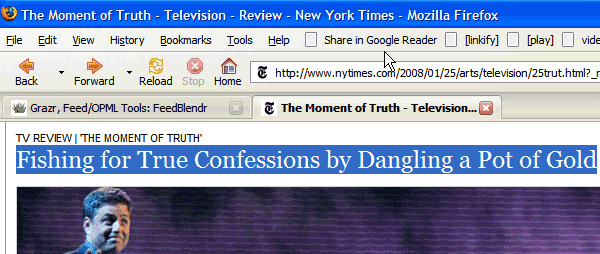


Share Almost Any Blog Post in Google Reader:
Google Reader's sharing feature is very cool, but it's limited to your subscriptions. If you find an interesting post and you want to share it with your friends without subscribing to the feed, Google Reader is not very helpful. On a closer look, you'll notice that Google Reader lets you preview any feed without subscribing to it if you go to this page:
But it's not that easy to find the feed and build that URL every time you want to share a post. And even if you do that, you'll still have to find the post.
So I created a bookmarklet that automates the process: it finds the feed and creates a different URL that tells Google Reader to search for the page's title in that feed. Hopefully, the first result is the page you want to share.
Here's how to add the bookmarklet to your browser (because of a Google Reader bug, this doesn't work in Opera and Safari):
1. Make sure the link toolbar is visible in your browser. You can enable it if you go to the View menu in your browser,
click on Toolbars and check:
* Bookmarks Toolbar in Firefox
* Links in Internet Explorer
2. Don't click on the link below!
For Firefox, right-click on the link, select "Bookmark this Link" and choose "Bookmarks Toolbar" from the dropdown. For Internet Explorer, right-click on the link, select "Add to Favorites", ignore the security warning and choose "Links" from the list of folders.
Note that you'll be able to share pages only from sites that have feeds and only if you go to the blog post, not to the blog's homepage. If the post is very recent, it's likely that Google Reader didn't index it yet. If the page's title is not identical to the post's title, select the title before clicking on the bookmarklet.
Credits: the bookmarklet contains code from Google Reader's subscription bookmarklet; based on a idea by Louis Gray.






































